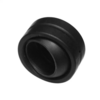DirtyHoe
Senior Member
Has anyone rebuilt the welded-in swivel bushing #7(part #D60803) on the frame where the stabilizer arm attaches? Are the welded on side plates machined with a partial sphere? I can't tell by the parts manual or with a flashlight looking at the worn-out mess.
This was a monster to get apart. I had to cut the pin with a cutoff wheel and pull the pin out. Then I blew a hole through the remainder of the short pin with a cutting torch. Had to use a hydraulic jack to press it out of the swivel bushing.
The upper bushing on the stabilizer is loose by .100". I plan on pad welding the egged-out hole where the bushing goes, them machining it for a press fit.
The cylinder rod was bent too.
Steve




This was a monster to get apart. I had to cut the pin with a cutoff wheel and pull the pin out. Then I blew a hole through the remainder of the short pin with a cutting torch. Had to use a hydraulic jack to press it out of the swivel bushing.
The upper bushing on the stabilizer is loose by .100". I plan on pad welding the egged-out hole where the bushing goes, them machining it for a press fit.
The cylinder rod was bent too.
Steve










